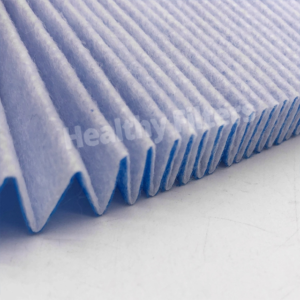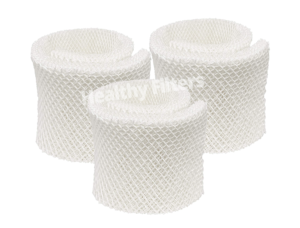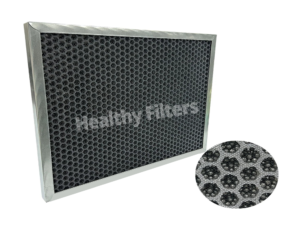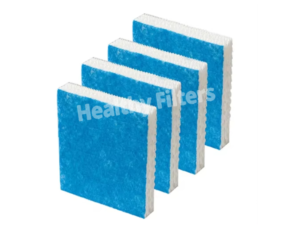Synthetic Fiber Pocket Filter F7 is a high-performance air filtration device that complies with EN 779:2012 F7 level (corresponding to ISO 16890 ePM1 70%-80% and MERV 14-15), and is designed to intercept 0.3-5μm ultrafine particles (such as bacteria, virus carriers, smoke, aerosols and industrial dust). It combines high-density electret fibers with optimized bag structure to achieve filtration performance close to HEPA level at low energy consumption. It is widely used in medical, pharmaceutical, electronic manufacturing and high-cleanliness commercial spaces, and is the core barrier to ensure air quality and process cleanliness.
Core structure and technical parameters
Material and process
Filter material:
Electret polyester fiber: fiber diameter ≤1.5μm, gradient density composite (outer layer coarse effect + middle layer dense + inner layer ultrafine), electrostatic electret technology improves submicron particle adsorption efficiency;
Optional functional layer: antibacterial coating (silver ion/copper ion) or hydrophobic treatment, suitable for medical and high humidity scenes.
Bag design: 12-24 V-shaped pleated filter bags, effective filtration area is 5-8 times that of flat filter material, dust holding capacity 800-1200g/m².
Sealing frame: galvanized steel or flame-retardant ABS frame, temperature resistant -30℃ to 80℃, edge silicone sealing ring to ensure zero leakage.
Performance parameters
Filtration efficiency:
PM1.0 filtration efficiency ≥75% (ISO ePM1 75%+), PM0.5 ≥65% (0.5μm particle interception rate ≥85%);
Complies with EN 779 F7 standard (average efficiency for 0.4μm particles ≥80%-90%).
Initial pressure difference: ≤90Pa (@rated air volume), energy consumption is 15%-25% lower than that of traditional F7 filter element.
Environmental tolerance: humidity ≤90% RH (anti-mildew model optional), resistant to weak acids and weak alkalis (pH 5-9).
Core advantages
Advantage dimensions Specific performance User value
High-efficiency purification Submicron particle interception ability close to HEPA (H11 level) Meet ISO Class 7 clean room or operating room air standards
Long life economy High dust holding capacity design, replacement cycle up to 12-24 months Operation and maintenance costs reduced by 30%, reducing downtime maintenance frequency
Safety and environmental protection No ozone release, in line with medical-grade biocompatibility (ISO 10993) Ensure the safety of personnel in sensitive environments (such as ICU, laboratory)
Flexible adaptation Support non-standard customization (thickness 100-600mm, number of filter bags 12-36 bags) Adaptive air volume 2000-15,000m³/h System requirements
Typical application scenarios
Medical and pharmaceutical:
Operating room, sterile preparation workshop, interception of bacterial and viral aerosols, support infection control;
Vaccine production line HVAC system, maintain GMP A-level cleanliness.
Electronic manufacturing:
Chip packaging workshop, optical lens production line, control particles above 0.3μm to ensure good yield;
Lithium battery production environment, prevent metal dust from contaminating electrodes.
Food industry:
Dairy product sterile filling line, intercept microorganisms and odor molecules;
High-temperature exhaust in baking workshop, filter grease smoke and coking products.
High-end business:
Precision air conditioning in data center, prevent dust from overheating servers;
Constant humidity and temperature system in museums and art galleries, protect collections from particle erosion.
Selection and maintenance guide
Accurate selection suggestions
Air volume matching:
Calculate the system air volume (m³/h) and select the number of filter bags (e.g. 18-24 bags are required for 10,000m³/h);
The wind speed is recommended to be ≤2.0m/s to avoid efficiency attenuation.
Pollution characteristics adaptation:
Biological pollution: select antibacterial coating filter material to inhibit microbial reproduction;
High humidity environment: hydrophobic frame + moisture-proof filter bag to avoid mildew.
Intelligent maintenance strategy
Pressure difference monitoring: Install a digital pressure difference gauge, and the recommended replacement threshold is the initial pressure difference × 2.5 (usually ≤225Pa);
Cleaning method:
Surface dust can be cleaned with a vacuum cleaner (wet wiping or high-pressure airflow is prohibited to avoid the failure of the electrostatic layer);
Directly replace when seriously blocked, cleaning and reuse are not supported.
Replacement cycle:
Conventional scenarios (office buildings, laboratories): 12-18 months;
High pollution scenarios (welding workshops, hospitals): 6-12 months.
Technological innovation and industry trends
Intelligent Internet of Things: Integrated IoT sensors, real-time monitoring of efficiency and pressure difference, synchronized to the cloud management system;
Composite function upgrade: optional activated carbon composite layer (VOCs adsorption) or photocatalytic coating (decomposition of formaldehyde);
Green manufacturing: using recycled polyester fiber (30% recycled content), carbon footprint reduced by 20%, responding to ESG goals.
Synthetic fiber bag filter F7 takes **”ultra-efficient filtration, intelligent operation and maintenance, and wide adaptation”** as its core competitiveness, becoming the preferred solution in the field of high cleanliness requirements. From life sciences to precision manufacturing, it not only protects air quality, but also drives the industry towards efficiency and sustainability through technological innovation.





